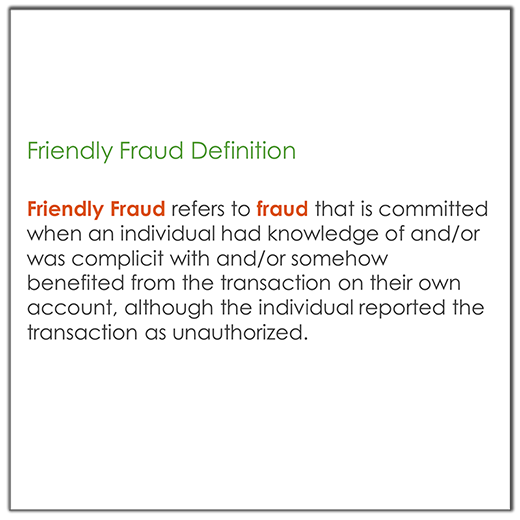
Friendly fraud is anything but friendly. Friendly fraud has grown in recent years with the rise of ecommerce. A customer makes a purchase online for a product or service with their credit card and then contacts their credit card issuer to dispute the charge.
This type of fraud is often referred to as friendly fraud because the customer will make claims that seem believable and honest. But in actuality, if this type of fraud was occurring in a brick-and-mortar shop, it would be called theft or shoplifting.
We want you to have the right information to be able to understand what this fraud looks like, to learn how you can prevent it, and know how to differentiate it from chargeback fraud.
What does friendly fraud look like?
The key to identifying friendly fraud is in knowing who your customers are, understanding their buying habits, and having key mechanisms in place to limit the chances of it occurring.
Some typical examples that customers will use when contacting their credit card issuer with a fraud claim include:
- The customer reports that the item wasn’t delivered.
- The customer claims that the item purchased doesn’t match the online description and now they don’t want it.
- The customer tells their credit card issuer that they returned the item but a refund was not processed.
- The customer says they cancelled the order but it was still sent to them.
- The customer says they don’t remember making the purchase so their credit card must have been compromised.
Keep in mind that some of these claims might in fact, be valid. This is why we have this category of friendly fraud because there is a chance that the customer is being honest and the reported problem has actually occurred.
Now that you know some of the most common reasons for these fraud claims, here is what you can do to dispute these claims:
- Have tracking and shipping mechanisms in place that allow you to verify that the customer did in fact receive their order. You may want to ensure the recipient of the product signs upon delivery. This creates a paper trail that shows the product was ordered and delivered. It’s important that you have access to this tracking and verification information.
- When a customer says the product does not match the description online, this is where your refund policy is very important. This information should be clearly displayed on your website and be easily available to the customer. Make sure your refund policy states that a refund is issued when the item is returned and specify a time period for this return.
- When a claim is made by the customer that the item was returned but a refund wasn’t issued, you need to provide the tracking and shipping information for the delivery and the return. Additionally, providing a paper trail that proves that the customer did or did not return the item is important. Consider an email and online account order history that clearly shows all transactions.
As you can see it’s very important to have clear and obvious documentation and tracking information. Make sure you are tracking orders, verifying deliveries, and have clear and accessible wording on your website.
Is friendly fraud preventable?
This is a challenging question to answer. While no fraud is 100% preventable, there are measures you can take to make it more difficult for friendly fraud to occur.
- Use stringent authorization and authentication software and solutions. These online systems require customers to enter their complete credit card information, allow them to verify and review their order, and can in large purchases send an email confirmation or initiate a phone call to finalize the purchase.
- Collect as much customer data as you can and make sure it is easily accessible. You need an effective and efficient customer database that includes the order history, delivery mechanisms and date, customer service contact with the customer and any other analytics that you can collect. Knowing your customers is key in making sure you’re not selling to customers who are known to make fraudulent chargeback claims.
- As we’ve stated above, make it very easy and simple for your customers to return their items. The easier it is to return an item, the harder it is to claim that the item was returned but a refund wasn’t issued or that the item doesn’t match the description. Provide a way for your customers to print pre-paid shipping labels and make sure there is a tracking code included on this label.
It really comes down to data and knowledge. The more information you can provide about the customer’s purchase and delivery, the harder it is for such fraud to occur.
https://www.dalpay.com/en/support/chargebacks.html
https://dalpayblog.com/2015/06/30/there-is-nothing-friendly-about-friendly-fraud/